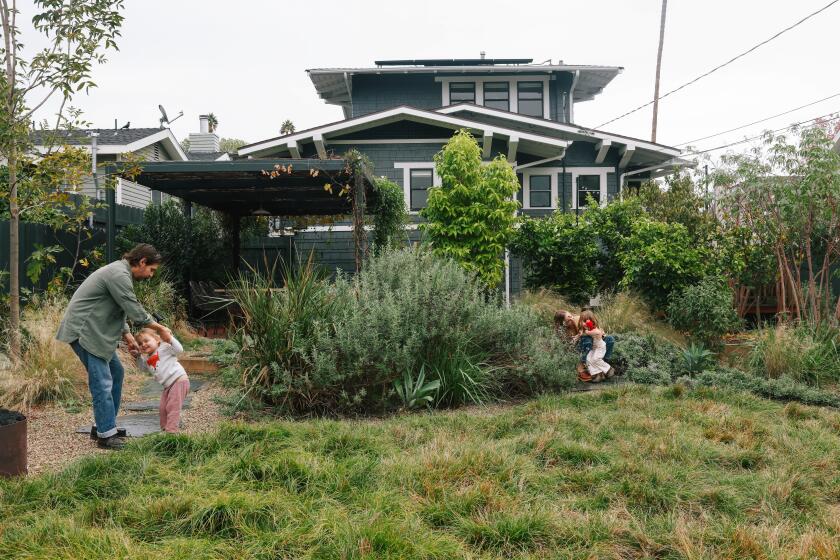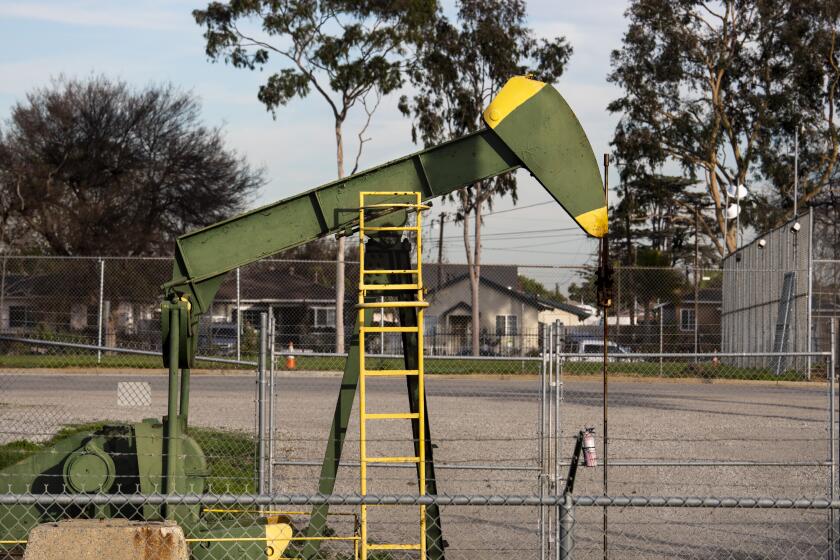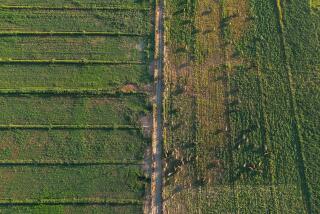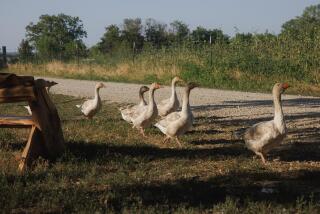Opinion: Why your green grass is making the temperature rise

- Share via
When you fired up your gas grill last weekend, threw on two juicy steaks, sipped water out of convenient plastic bottles and cranked up the heat in the pool to take off the chill, did you suffer a pang of guilt about your carbon footprint? Fear not. None of these activities were the worst contribution to climate change in your backyard.
How did you get that lush green lawn and bug-free garden? If you’re like many Americans, you got it through the use of synthetic weed killers, bug killers and fertilizers. As renewable energy and electric cars are gaining a foothold, oil and gas companies are filling the void by ramping up petrochemical production, and that includes pesticides and fertilizers.
Gardeners and homeowners have to do their part in walking that back.
Petrochemical production and sales have doubled since 2000, and the market is expected to double again over the next 10 years according to the Global Chemical Outlook published by the United Nations. Derived from hydrocarbons, petrochemicals are the basic ingredient in synthetic pesticides and fertilizers (and plastics, but that’s another story). Their manufacture releases greenhouse gases and toxins into the air, and their use contributes to making agriculture the second-largest source of climate pollution. Pesticides are worse than fertilizer, requiring 10 times more energy to synthesize.
Kyle and Claire Penn pulled out their lawn in Eagle Rock and never looked back. “We haven’t given up anything by not being able to run around on grass,” Kyle says.
Obviously, farmers are the major market for fertilizer and pesticide, but according to NASA satellite data, there are actually more lawns than cornfields in the United States. And homeowners use up to 10 times more chemicals per acre than farmers, which means yards and gardens are also a huge contributor to greenhouse gas emissions.
It gets worse. One of the key impacts of using synthetic pesticides and fertilizers is an increase in nitrous oxide production. The greenhouse gas impact of N2O is 300 times more powerful than carbon dioxide’s. Additionally, nitrous oxide attacks the ozone layer, our key defense against the sun’s ultraviolet rays.
Too much fertilizer, which is packed with nitrogen, is a large part of the problem. Crops can only use about half of the nitrogen currently applied to farm fields, and homeowners’ overuse only compounds the situation.
Advertising presents images of perfect lawns, leading us to believe that more and more fertilizer will turn our yards into landscaping showpieces. The reality is that excess nitrogen just runs off fields, fueling algae blooms and poisoning rivers, streams and lakes and seeping into groundwater. What doesn’t run off stimulates soil microbes to produce much larger amounts of nitrous oxide than they would if left to their own devices. Pesticides aren’t as big a nitrogen culprit as fertilizer, but their use also increases nitrous oxide release — sevenfold.
Here are the best retail native plant nurseries in Southern California to help you create a habitat for birds and pollinators in your yard or even on a patio.
Synthetic fertilizers and pesticides are also biocides — meaning they kill bacteria and fungi in the soil, including the good ones that make up the normal, healthy microbiome.
In healthy soil, as beneficial bacteria and fungi reproduce, thrive and decay, the process sequesters carbon and naturally feeds the plants. This benefit is removed when the organisms are killed by chemicals. At the same time, when biocides disrupt the soil microbiome, they remove natural protections that defend plants against harmful bugs and bacteria.
Synthetic pesticides in particular create a vicious cycle that releases more greenhouse gases: Insects and weeds become resistant to the chemicals, growers use more, killing even more beneficial soil organisms and incentivizing more pesticide manufacturing and releasing more greenhouse gases.
What’s a gardener to do? We can each make huge dents in our greenhouse gas contributions and enjoy beautiful gardens without chemicals. Here are some simple techniques that support soil health without fertilizers and pesticides.
First, landscape your home and garden with native plants that are already well-adapted to local conditions. Replacing grass with natives is one of the easiest and most beautiful ways to landscape without chemicals. As a residual benefit, you will see a marked increase in birds, butterflies, bees and other wildlife in your gardens, making them even more alive.
A new study shows that fossil fuel investments dramatically underperformed for CalSTRS, CalPRS and individual retirees over the last 10 years.
If you stick with grass, grow less of it and aerate it. Spread grass seed, instead of fertilizer, to keep it lush and to out-compete weeds. Throw away the bag on your electric lawn mower, leaving clippings and leaf mulch on the lawn as compost.
Garden naturally and engulf yourself in the dividends: hummingbirds hovering at your manzanita blossoms. Bees so busy you can watch them up close without danger of being stung. A cedar waxwing with a toyon berry in its mouth. Western bluebirds that do you the favor of eating caterpillars off your tomato plants. A kaleidoscope of butterflies that glide together to sleep in the trees as dusk settles in.
Along with all this comes the satisfaction of knowing you’re playing a crucial role in preventing climate change.
Diane Lewis is a physician and founder of the Great Healthy Yard Project.
More to Read
A cure for the common opinion
Get thought-provoking perspectives with our weekly newsletter.
You may occasionally receive promotional content from the Los Angeles Times.













